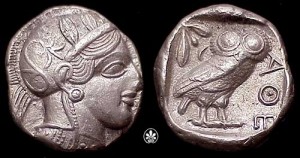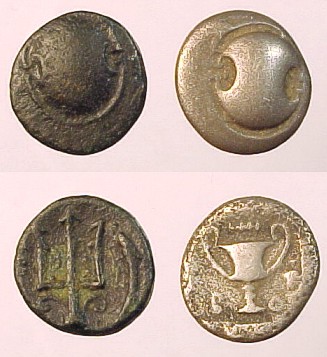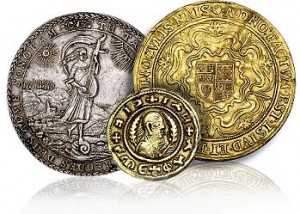The history of Ancient Greece has been reconstructed by interpreting the archaeological and architectural evidence available. But there is another source which is sometimes overlooked but has helped in giving many useful information about Ancient Greece, i.e., the coins. The coins have given many information about culture, important personalities and their international relations.
History of coins
From the start of around 600 BC, the entire Greek city-states started to make their own types of Coins and the first to issue their own coins was the state of Aegina and these were made of silver. The most used and common Ancient Greek coins were known as Drachma.
Earlier, trace and transactions used to be conducted by barter exchange of goods. But with some things like metal bars made of bronze or copper started to be used as money and then metal rods or spits of about 1.5 meters were used.
The first ones to use coins as currency in the Greek world were the Ionians from Lydia and the states came in contact with these Ionians through trade.
Soon they realised that the coins were a more portable and convenient form of metal rods which made exchange easier. The cost of making the coins was also lower than the real value of these coins which made minting less costly and states made a profit.
So after Aegina, the use and minting of coins soon spread around the Greek mainland very fast. Although barter continued along with the metallic coins still the Greeks understood the advantages of using these coins which made them very popular in Ancient Greece.
How were Ancient Greek coins made?
The most commonly used metal to make the Ancient Greek coins were silver but also materials like gold, an alloy of silver and gold known as electrum, copper and bronze were used. They were made by simply taking a tiny little lump of silver and then putting the lump on an iron mold and then striking this mold using a hammer which had a different kind of mold in it. this way a picture could be squashed into both of the sides at the similar time. Special care was taken to maintain a standard weight and shape of these coins by each state.
Ancient Greek coins’ value
Some Ancient Greek Coins meant more in value than others. The gold coins were valued more than the silver coins and similarly, the silver coins were valued more than the bronze ones. Even the weight was considered to ascertain the value of the coins. A heavy coin was valued more than a light one.
Sometimes, the value of the coins was decided by the power of the state as the coins of a wealthy state like Athens were more in demand than the coins of less powerful states, so a coin of Athens could be more in value than a similar coin of a weaker state, as the value ultimately came from the acceptability and demand for the coin.
There were certain other kinds of coins other than the silver Drachma and these denominations were
12 chalkoi = 1 Obol
6 obols = 1 drachm
100 drachma = 1 mina
60 minas = 1 talent
The coin with the smaller value was called an obol and usually, those laborers who dug ditches or unloaded boats would get around two to three obols a day.
One small silver Drachma was average the wage of one day for the ancients Greeks while a large silver Drachma coin was worth luxuries jewelry, horses, etc.

Designs on the coins
Every city state had its own style of coins different from the others. One of the most popular fighters found on these coins was the Greek gods from their mythology.
Earlier only geometric shapes were stamped on the reverse side but later the reverse side was also stamped with different designs to deliver messages like the olive branch on the Athenian drachma.
Some special creatures were also depicted on these coins like the winged horse on Corinthian coins. Similarly, local flora and fauna were another popular figures depicted on these coins like the Roses on the coins of Rhodes.
The coins also depicted political propaganda on their coins. For example, the Athens stamped coins commemorating their victory over the Persians. the symbols and figures on the coins had symbolic meanings which announced the outlook of the states.
List of Ancient Greek coins by city
-
Aegina: The city of Aegina was the first of the greek city-states to issue metallic coins. Their coins were even used in Egypt and Levante and their badge was the tortoise which included a design known as the ‘skew’ on the reverse side.
- Rhodes: Rhodes was a wealthy Greek city which issued its own gold coins and is considered to be one of the most beautiful among the coins of Ancient Greece. The Greek sun God, Helios was depicted on the obverse side and a rose was depicted on the reverse side.
- Thebes: Thebes was one of the most powerful states in the Greek world and had one of the most distinct coins. The Boeotian shield was featured on its obverse side and an amphora on its reverse side.
- Athens: One of the most valuable and well known coins was of the Athenians. They featured the owl on their coins and were one of the finest and most prized numismatic depictions.
- Corinth: Corinth was a city which attributed its prosperity due to foreign trade and so for them, their coins were very important. The Corinthian coins commonly depicted the mythical winged horse of Bellerophon known as the Pegasus and on the reverse side features the head of Athens wearing the Corinthian helmet
- Sparta: The Spartans had the most peculiar use of money like many of their other things. The Spartan culture looked down on prosperity and material pleasures, which forbade them to use typical coins. They used large iron ingots known as Pelanoi instead of silver coins.

Coins of different ages
The Ancient Greek Coin actually had three periods.:
The Archaic period
The very first coins were issued in the Archaic period from Aegina. But very soon Athens with their supply of silver from the mines of Laurion increased their dominance which contributed to their success in the era. The coins of this age were found in foreign lands like Egypt and Levant. Proper attention was given to maintaining the same standard in the coins.
The Classical Period

The Hellenistic Period
Finally came the Hellenistic period where the Greek culture had started to spread throughout the rest of the world. Various Greek-speaking kingdoms also started to be established in places like Egypt, Syria and so on. Since the kingdoms were actually a lot wealthier, the coins were also being produced in mass orders. But then these ancient Greek coin didn’t have the aesthetics of the previous age. The portraits of living characters mostly of kings became to be depicted like the Seleucid coins. they were one of the magnificent depictions of numismatic art with a blend of realism and idealism.
What is the rarest Greek coin?
The Athenian Dekadrachm is the most rare Ancient Greek coin which weighs about 42 grams and only 40 of them have been discovered, which makes them extremely valuable, being worth in millions.